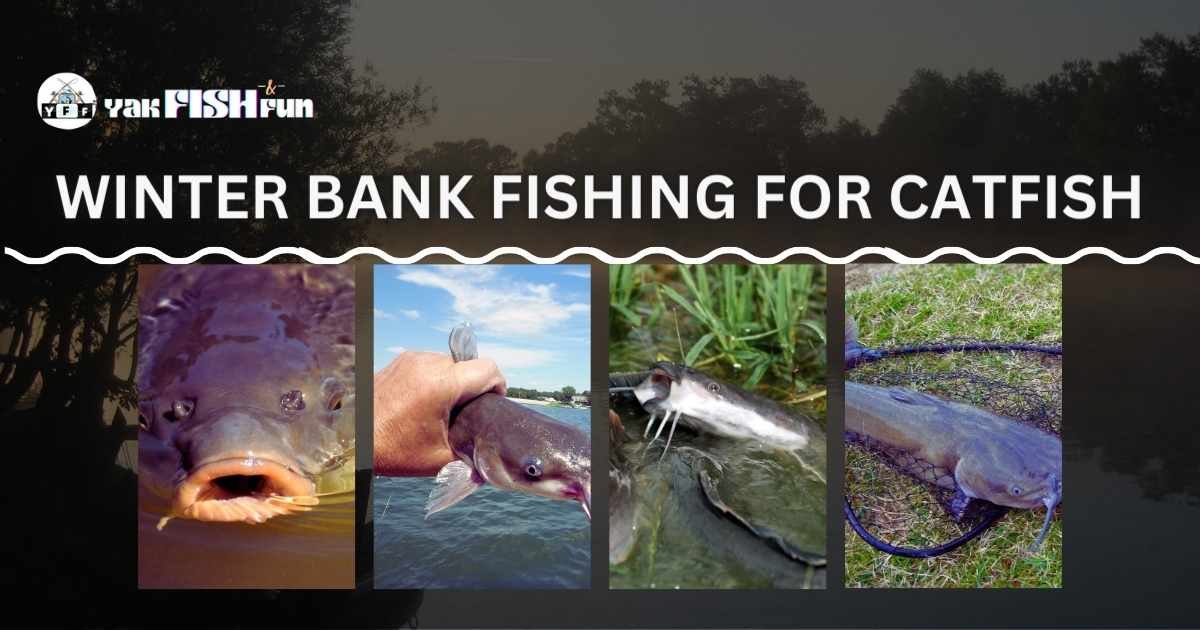As winter’s icy grip takes hold of the waters, most anglers opt for cozy firesides, but a special breed of fisherman seeks solace and adventure in the frosty world of winter bank fishing for catfish from their trusty kayaks. They call it the “Chill Thrill.”
Winter kayak catfishing is no walk in the park. It’s a realm where nature challenges your every move, the waters are colder, and the fishing tougher. Yet, it’s also where you’ll find a unique thrill, distinct from the balmy days of summer.
Unlike summer, when catfish are active and easy to locate, winter poses a different challenge. The cold makes them lethargic, and they become elusive. But don’t be discouraged.
This guide is your key to mastering winter bank catfishing from your kayak. We’ll talk about how catfish act in the cold, give you practical tips on gear and techniques for winter fishing, and explain what makes winter fishing different from summer fishing.
Table of Contents

Understanding Catfish Behavior in Winter For Fishing
Catfish fishing during the winter months presents unique challenges and rewards. As temperatures drop, catfish behavior undergoes significant changes. To successfully catch catfish from the bank in winter, it is crucial to understand how their behavior shifts and adapt your fishing techniques accordingly.
Catfish Metabolism in Cold Water
Cold water has a profound impact on the metabolism of catfish. Being cold-blooded creatures, their body temperature is influenced by the environment. In colder water, catfish become less active as their metabolic rate slows down. This decreased activity directly affects their feeding habits, making them eat less frequently.
Feeding Patterns in Winter
During winter, catfish exhibit altered feeding patterns due to their slowed metabolism. With reduced activity levels, they are less inclined to chase after prey or consume large quantities of food. Instead, they tend to target smaller baitfish or other food sources requiring less energy.
Preferred Locations
Understanding where catfish hide during winter is essential for successful bank fishing. During this season, catfish are pretty tough, and they like to hang out in deeper water or places where the temperature doesn’t change too much. They also love hiding around things like logs under the water or big rocks sticking out. That’s where you’ll find them when you’re out fishing for catfish.
Adaptations to Cold Water
Catfish possess physical adaptations that aid their survival in cold water conditions. Their lower metabolic rate allows them to conserve energy while enduring lower temperatures. They may migrate towards areas with higher oxygen levels to ensure their continued well-being throughout winter.
Behavioral Changes
In the winter, catfish act a bit differently, and if you want to catch them from the shore, you need to know what’s going on. They don’t move around as much and are pickier about what they eat. So, you’ve got to change how you fish for them. Use the right gear and methods to match how the catfish act in winter. It’s all about being patient, knowing that they’re slower now. Keep an eye on the weather, too, because it can affect when and where the catfish are active. Understanding these changes can help you catch more catfish during the winter.
Tactics for Successful Cold-weather Bank Catfishing
Employing the right tactics can make all the difference between a successful day on the water and going home empty-handed.
Selecting the Right Gear
Before heading out for a cold-weather catfishing adventure, ensuring you have the appropriate gear is crucial. Here are some essentials to consider:
- Rods and Reels: Opt for medium to heavy action rods paired with sturdy reels capable of handling larger fish.
- Lines: Choose a strong and durable line with a test weight suitable for targeting catfish.
- Specialized Equipment: If it’s windy and you want to keep your boat from moving too much, think about using a drift sock or an anchor system. These things help you stay in one place and fish more easily.
Don’t forget about clothing and accessories:
- Insulated Clothing: When you go fishing, especially in cold weather, make sure to wear warm clothes in layers. This way, you can stay cozy during your entire fishing adventure.
- Gloves and Headwear: Protect your extremities by wearing gloves that allow dexterity while keeping your hands warm. Don’t forget a hat or beanie to retain body heat.
Bait and Presentation Techniques
During winter months, when water temperatures drop, catfish tend to become less active but still need nourishment. To entice them effectively:
- Bait Selection: Fresh bait is essential when targeting catfish in cold water. Look for options with strong scents or natural appeal, such as cut shad or skipjack herring.
- Presentation Strategies: Adjust your presentation by placing baits closer to the bottom, where sluggish catfish often reside. Experiment with different depths until you find success.
Location and Timing
In the winter, it’s important to know where catfish like to hang out along the riverbank to catch them successfully.
- Finding Productive Spots: Search for spots where the water is deep, there are things under the water like logs or rocks, or where the riverbed suddenly gets lower—catfish like to hide in these places when it’s cold. Please pay attention to their movement patterns, as they may migrate to warmer areas.
- Timing Considerations: Catfish are more active during warmer parts of the day, so plan your fishing trips accordingly. Keep an eye on changing weather conditions, as they can influence catfish behavior.
Adapting to Changing Conditions
When fishing in cold weather, it’s crucial to remain flexible and adapt your tactics to changing conditions:
- Flexibility: Be ready to change how you fish and try different things if the fish aren’t biting like you thought they would.
- Anchoring vs Drifting: Try out both anchoring and drifting techniques in different situations to figure out which one works better for you.
Safety and Preparedness
Lastly, prioritize safety when venturing out for winter catfishing. Dress appropriately in warm clothing, including waterproof outer layers if necessary. Avoid ice hazards, and always let someone know about your fishing plans before heading out.
By employing these tactics and strategies tailored specifically for cold-weather bank catfishing, you’ll increase your chances of success while enjoying the thrill of reeling in those elusive winter catfish.
Best Bait for Bank Catfishing in Winter
During winter, catfish can become sluggish and less active due to the colder water temperatures. This makes bait selection crucial.
Natural Baits
Natural baits can be incredibly effective. These baits mimic the scent and appearance of a free meal, enticing even the most sluggish catfish to bite. Here are some natural bait options you should consider:
- Nightcrawlers: You can easily find these big worms at bait shops. You can use them whole or cut them into smaller pieces when you go fishing.
- Minnows: Live minnows or frozen minnows work well as they imitate small fish that catfish feed on.
- Cut Bait: Using sections of fresh-cut fish, such as shad or herring, can release strong scents that attract hungry catfish.
It’s important to know when and how to use these natural baits to maximize their effectiveness. For example, nightcrawlers are often more effective in slower-moving water, while minnows work best in areas with stronger currents.
Stink Baits
Stink baits are another option worth considering during winter bank catfishing. These baits have a strong odor that is irresistible to catfish. They come in various forms, such as dough-like concoctions or pre-made dip baits. Some popular stink bait options include:
- Punch Baits: These sticky mixtures are made to stay on your fishing hook for a longer time, slowly letting out their strong smell.
- Cheese Baits: Made with cheese-based ingredients, these baits have a strong smell that drives hungry catfish crazy.
- Blood Baits: These baits are created using blood and other stuff, and they make a smell that catfish can’t resist.
Stink baits work well in cold water because catfish rely on their sense of smell to find food. You can try different smells and textures to figure out which stink bait works best for you.
Prepared Baits
If you want something easy, think about using baits that are ready-made or made for catfishing specifically. These baits come in various forms, such as pellets, dough balls, or dip baits. Some advantages of using prepared baits during winter catfishing include:
Related: Best Homemade Bait for Saltwater Fishing Form A Kayak
- They are less messy compared to natural or stink baits.
- They often have strong scents that attract sluggish winter catfish.
- They are readily available at most bait shops.
When you use ready-made baits, make sure to follow the instructions from the manufacturer. This way, you’ll set up the bait correctly and increase your chances of getting a bite from a winter catfish.
Bait Presentation Techniques
Once you’ve chosen your preferred bait option, proper presentation becomes crucial.
Create a scent trail by adding additional scents or oils to your baited area. This helps attract nearby catfish even before they reach your hook.
Making the Most of Winter Catfishing from the Bank
Winter catfishing from the bank is super cool because it’s like a special adventure for people who are brave enough to face the cold weather.
You might be wondering why anyone would want to go fishing in the winter. Well, let me tell you, my friend! When the temperature drops, catfish become more active and hungry. They start looking for food to fatten up before the winter really sets in.
And that’s where we come in! But hold on a minute. It’s not as easy as it sounds! You see, during the winter, catfish tend to move to deeper parts of the water where it’s warmer.
So, we need to figure out where they’re hiding.
Look for areas with structures.
One trick is to look for areas with structures like fallen trees or rocks. Catfish love to hang out near these spots because they provide shelter and safety.
These places are like perfect homes for catfish because they keep them safe from other animals that might want to catch them. The things underwater also give catfish lots of good hiding spots to take a break and surprise their food. So, if you want to catch a big catfish, make sure to look around these underwater spots.
So, if you’re looking to reel in a big one, be sure to explore the nooks and crannies around these underwater structures.
Wait for them to bite.
Remember, catfish don’t move around much when it’s cold, so we have to be patient and wait for them to bite. It might take some time, but trust me, it’s totally worth it when you feel that tug on your fishing line!
During the colder months, catfish tend to be less active, so it’s important to have some patience when trying to catch them. It may take some time for them to show interest in your bait and take a bite. However, once you feel that tug on your fishing line, the excitement and satisfaction of reeling in a catfish make the wait well worth it. So, be prepared to wait it out and enjoy the reward of your patience when you finally catch one.
Preparing for a Winter Catfishing Expedition
Preparation is key. Ensuring you have the right gear, clothing, and knowledge will greatly enhance your experience on those cold days by the water.
Essential Gear and Clothing
To withstand the chilly temperatures, it’s essential to dress appropriately. Layering is crucial for trapping warmth while allowing flexibility. First, wear a moisture-wicking base layer to keep sweat away. Then, add warm layers like fleece or wool. Finally, wear a windproof and waterproof outer shell to protect yourself from cold winds and sudden rain or snow.
Buying fishing gear made for winter can really help you catch more catfish. Think about getting strong rods and reels that can handle big fish like blue catfish, which are common in winter. Also, use rigs that are made for catching catfish in cold water. This will make it more likely for you to catch catfish.
Remember safety gear! Ice cleats or traction devices are vital when navigating icy or slippery banks. It’s a good idea to wear a life jacket, especially when you’re fishing near frozen lakes or rivers where the ice thickness can change.
Pre-trip Planning
Before you go winter catfishing, it’s smart to plan ahead. Look up the rules in your area to ensure you have the right fishing permits and are not catching too many fish. It will save you a lot of trouble later.
Keeping an eye on weather forecasts is crucial during this season. Cold weather changes how fish act, so knowing the weather can help you change your fishing style. When you see sunny days after a cold spell, it often makes catfish more active. They start looking for warmer spots in the water.
Furthermore, familiarize yourself with specific fishing locations. If you know where catfish like to hang out in the winter, like deep holes or spots near things that hide them, it’ll help you find and catch more of them.
Staying Warm and Comfortable
Fishing for catfish in the winter from the shore can be cold, but with the right plans, you can stay warm and cozy during your trip.
Layering Techniques
Layering isn’t just about clothes; it also applies to how you fish for catfish in winter. Catfish get slower in cold water, so you should slow down how you fish. Use bait that smells really strong to get their attention.
Managing Daylight Hours
The days are shorter in winter, so you must use your fishing time wisely. Get to your fishing spot well before the sun comes up so you can start fishing as soon as it gets light. You might want to buy a headlamp or portable lights so you can keep fishing even after it gets dark.
Adapting Gear for Winter Conditions
Cold weather brings unique challenges for anglers. One of these is managing frozen bait. Consider using insulated containers or keeping your bait inside a cooler with hand warmers to prevent it from becoming rock solid. This will help keep it pliable and attractive to hungry cats.
Another adaptation involves adjusting your rig setup.
Bottom Line
Winter catfishing from the shore can be a fun and rewarding adventure. Understanding how catfish behave in cold weather is important to catch them successfully. Using the right techniques, good bait, and spending your time wisely can improve your chances of catching big catfish, even in winter.
So, why wait? Put on warm clothes, gather your fishing gear, and head to the nearest river or lake for some exciting winter catfishing. With patience and determination, you’ll have a chance to catch some really big catfish. Remember to adjust your tactics as the conditions change and try different baits to see what works best for you. Don’t let the cold weather stop you – embrace it as a chance to test your skills and enjoy the beauty of nature.


